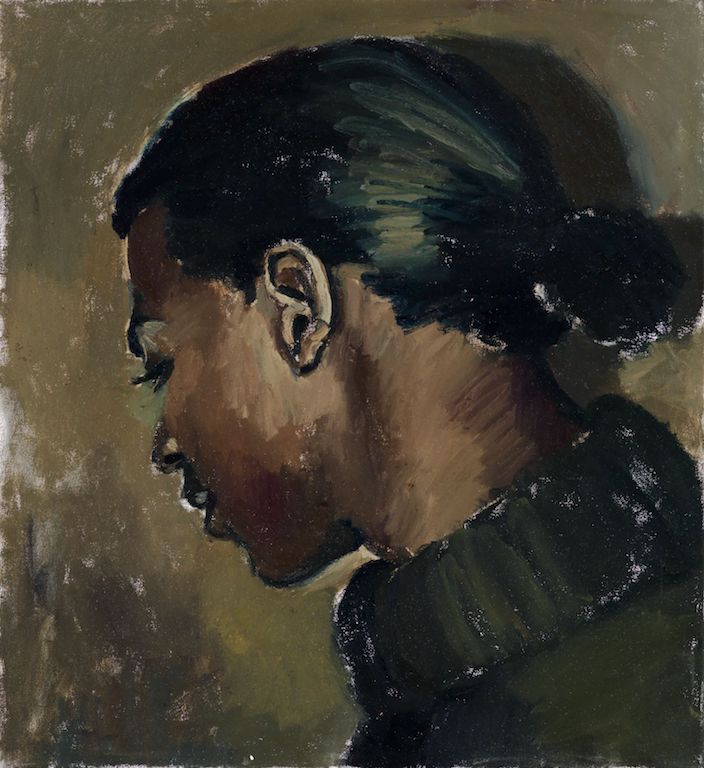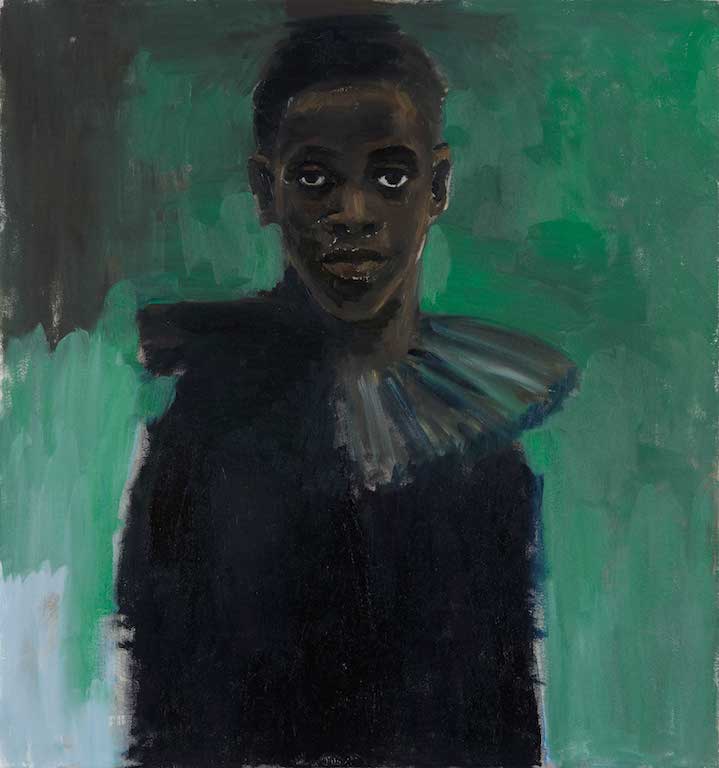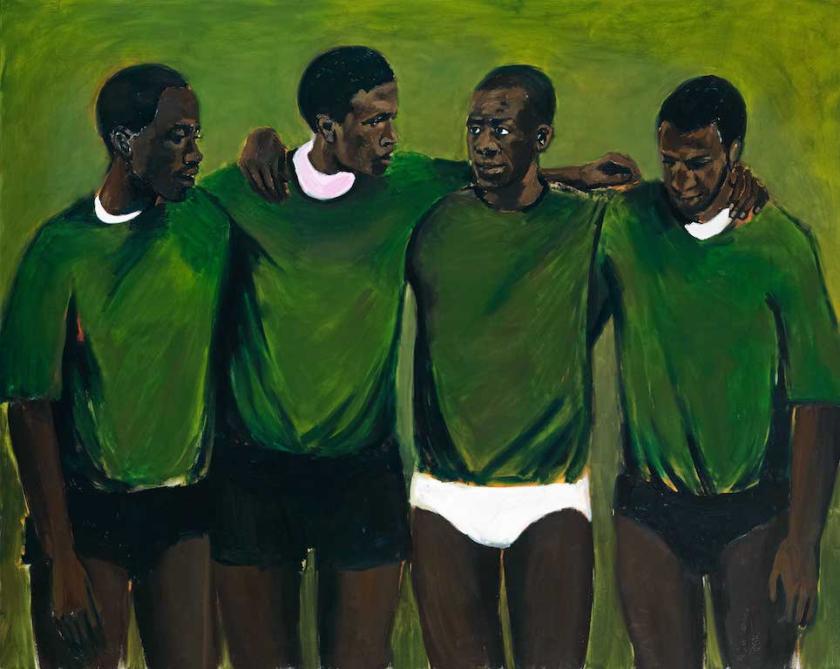A person in a brown polo neck turns away, looking down (pictured below right). The encounter feels really intimate; we are almost breathing down this beautiful neck and exquisitely painted ear. Yet the subject retains their privacy; you can’t even be sure if this is a man or a woman.
Lynette Yiadom-Boakye paints people, yet her pictures are not portraits. They are not drawn from life, but from her imagination and the store of images inhabiting her mind. Her subjects are not sitters, posing at her behest, but characters minding their own business and getting on with their lives. Such an assertion of independence shouldn’t be remarkable but since, like Yiadom-Boakye herself, her subjects are black, it feels radical. In western art, black people have traditionally been assigned subordinate roles, either as servants submissive to their white employers or as exotic others on display for our entertainment.
 For Yiadom-Boakye this is simply not an issue. “Blackness has never been other to me”, she says. “Therefore I’ve never felt the need to explain its presence in the work any more than I’ve felt the need to explain my presence in the world… Following my own nose and doing as I damned well pleased always seemed to me the most radical thing I could do. It isn’t so much about placing black people in the canon as it is about saying that we’ve always been here, we’ve always existed, self sufficient… and in no way defined or limited by who sees us.”
For Yiadom-Boakye this is simply not an issue. “Blackness has never been other to me”, she says. “Therefore I’ve never felt the need to explain its presence in the work any more than I’ve felt the need to explain my presence in the world… Following my own nose and doing as I damned well pleased always seemed to me the most radical thing I could do. It isn’t so much about placing black people in the canon as it is about saying that we’ve always been here, we’ve always existed, self sufficient… and in no way defined or limited by who sees us.”
Without any song and dance, then, she fundamentally shifts both perceptions and power relations. She accords black people dignity and respect and, by giving no clues as to the identity of her subjects, leaves us floundering. We become the outsiders, offered mere glimpses into lives about which we can only speculate. And the titles are as deliberately enigmatic as the paintings. For instance, the picture I described is called To Tell Them Where It’s Got To, 2013.
So we are left to our own devices, invited to look and draw our own conclusions, and the challenge is well worth the effort. Everything in this beautiful picture is rendered in soft browns and blacks except for tiny patches of bare canvas that suggest light glinting off the subject’s throat and upper lip – just one of the details that magically conjures a convincing presence out of oil paint and imbues it with inner life.
Born in London, Yiadom-Boakye studied painting at Falmouth College of Art and the Royal Academy schools and was shortlisted for the Turner Prize in 2013. "I learned how to paint from looking at paintings", she says. "In that sense, history serves as a resource." Rembrandt and Frans Hals must have been on the agenda, not to mention Degas, yet her paintings feel really fresh, partly because of her lightness of touch, and partly because of their humour. Complication 2013 (main picture) shows four team mates chatting. They are standing in a row, arms round one another which, compositionally, looks really naff. Their dark green and black sportswear blends into the green ground; but glimpses of white t-shirts, a pair of gleaming white underpants and the whites of a player’s eyes leap out at you, as though to mock the rules of serious painting with pure comedy.
 Many of her figures emerge from the background like phantoms reluctant to show themselves. The smoker in A Whistle in a Wish, 2018 seems hardly more substantial than the cigarette smoke wafting from her mouth and blending with the dark backdrop.
Many of her figures emerge from the background like phantoms reluctant to show themselves. The smoker in A Whistle in a Wish, 2018 seems hardly more substantial than the cigarette smoke wafting from her mouth and blending with the dark backdrop.
In contrast, the head of the young woman in A Passion Like No Other, 2012 (pictured above) is dramatically articulated against a turquoise ground. She stares out, as though challenging us with her presence, daring us to banish her. The extraordinary vehemence of her gaze is offset by the strange collar draped round her neck like a pierrot’s ruff and the way her body flattens into nothing more than the rapid brushmarks used for the background. Despite her intensity, she is only a painting, after all.
The enormous pleasure of Lynette Yiadom-Boakye’s pictures is twofold, then. How to deploy the language of painting and make it relevant in the 21st century is one theme; bringing black people out from the shadows and giving them visibility is another.
- Lynette Yiadom-Boakye: Fly in League with the Night at Tate Britain until 9 May
- More visual arts reviews on theartsdesk









![SEX MONEY RACE RELIGION [2016] by Gilbert and George. Installation shot of Gilbert & George 21ST CENTURY PICTURES Hayward Gallery](/sites/default/files/styles/thumbnail_125_x_125_/public/mastimages/Gilbert%20%26%20George_%2021ST%20CENTURY%20PICTURES.%20SEX%20MONEY%20RACE%20RELIGION%20%5B2016%5D.%20Photo_%20Mark%20Blower.%20Courtesy%20of%20the%20Gilbert%20%26%20George%20and%20the%20Hayward%20Gallery._0.jpg?itok=3oW-Y84i)





Add comment